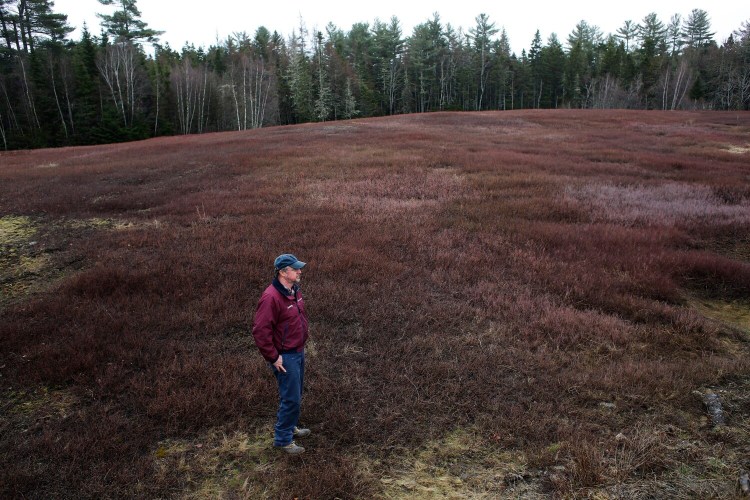Maine’s 2018 wild blueberry harvest was the smallest in more than a dozen years, but prices paid to farmers rebounded after years of declines.
That’s good news for the state’s 485 blueberry growers as they deal with a glut of their product on the market caused by the arrival of lower-priced cultivated berries. Concerns continue this year as a cool, rainy spring followed by a hot dry summer are taxing Maine’s berry production.
“It is everything together, it continues to impact the industry,” Harrington grower Courtney Hammond said of the weather and market pressures.
Maine blueberry farmers harvested 50.3 million pounds last year, less than half of what the state produced just five years ago, according to recent data from the U.S. Department of Agriculture. But the price for the smaller crop nearly doubled from 2017, to almost 46 cents a pound.
Blueberry growers hope improving prices are a signal the industry may be on the rebound after years of overproduction and low prices, said Patricia Kontur, interim executive director of the Wild Blueberry Commission of Maine.
“We are hoping we are going up, our fingers are crossed and we are trying to be as optimistic as possible,” Kontur said.

Maine produced more than 100 million pounds of wild blueberries a year between 2014 and 2016. That production surge created a glut in the market as Maine contended with competition from Canadian growers and the powerful cultivated blueberry industry.
Prices plummeted to 25 cents a pound for frozen berries in 2017, the lowest price in 32 years. Almost the entire wild blueberry crop in Maine is frozen by a few large processing companies.
It’s positive that prices have come up from last year’s slump, but the industry “is still going through a very challenging period where small harvests have led to high costs, while at the same time, prices have remained significantly below historical averages for both growers and processors, due in part to increased global supply of ordinary, cultivated blueberries,” said Tony Shurman, president and CEO of Wyman’s of Maine, a major berry growing and processing company in Milbridge.
Facing depressed prices, some growers have opted not to harvest their fields. Farmers raked 18,800 acres of blueberries last year, about 4,000 fewer than four years before.
A lot of that oversupply has now been sold off, and a smaller harvest means better prices for growers and companies that brought in a crop last year, Kontur said. The hope is the industry can return to stable prices and production, enough to consistently provide product for customers, she added.
“It looks like now we are in a much better place after a couple years of low crops.”
NEW MARKETS FOR A ‘SUPERFOOD’
The Wild Blueberry Association of North America, the industry’s marketing arm, pioneered selling berries as a “superfood” filled with antioxidants and other healthy properties, but has struggled to differentiate Maine’s wild berries from the larger cultivated varieties.
The association is testing new markets for berries, including chain restaurants and food service companies, Kontur added. Its work is funded with a 1.5 cent per-pound berry tax.
“We are trying to build the food service side, so that businesses, whether it is a chain restaurant or specialty restaurant, begin to use more wild blueberries in their recipes,” Kontur said.
Last month, Maine Agriculture Commissioner Amanda Beal and the state’s congressional delegation asked the USDA to include wild blueberry growers in a $16 billion federal purchasing and marketing program to assist farmers hurt by retaliatory tariffs in an ongoing trade war with China.
The federal government plans to buy $5 million worth of blueberries as part of the program, but a USDA spokesman did not respond when asked whether the purchase included cultivated blueberries or only wild blueberries. Last year, the federal government bought $9.4 million of surplus berries.
The industry’s economic woes broke into political tensions this year, when small independent growers pushed for equal representation with processing companies on the state commission. A law to amend commission membership goes into effect next month.
SPRING’S SIGNIFICANT DAMAGE
While a bump in prices paid to farmers is welcome news, a tough growing season may dampen hopes for increasing yields. A cold, rainy spring made blueberry barrens too wet to work in, delaying pollination and fostering fungal diseases. Hot, dry weather in July has stressed plants.
Hammond, the blueberry grower from Harrington, expects a smaller harvest than last year. Based on what he’s seen in his and other fields, the bad spring weather did significant damage. In other areas, fields are losing productivity because growers haven’t had the money to invest in fertilizer and other inputs to maintain all their land.
An acre of wild blueberry land had an average yield of 2,680 pound last year, almost half of what it was in 2014.
Hammond’s family operation lost money when it sold its harvest to a processor to freeze last year and they had planned to sit this season out. Hammond’s fresh blueberry business is doing well and he intended to focus on that this year instead of gambling on whether frozen berries would turn a profit.
But when a processor offered him a last-minute guaranteed minimum price for his berries, Hammond scrambled to prepare 200 acres with bees, pesticides and fungicides. Now it’s a waiting game to see if it works out.
“I’ve got my fingers crossed, that’s all I can say,” he said.
Send questions/comments to the editors.



